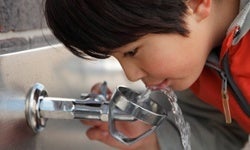September 17, 2012 — One in three U.S. children are overweight or obese, and growing evidence points to the empty calories they consume from sugary beverages as a substantial part of the problem. A new study by Harvard School of Public Health (HSPH) researchers finds that efforts to serve children in after-school programs plain water and replace juice with whole fruits and vegetables dropped the calories they were consuming in liquid form by nearly 70 per day.
“Millions of children spend a good portion of their day in after-school programs, but previous studies in this setting have been limited in scope,” said Katie Giles, project manager at the Harvard School of Public Health Prevention Research Center and the study’s lead author. “This is the first randomized control trial we know of in after-school settings looking at water specifically.”
The study was published in a September 2012 supplement to the American Journal of Preventive Medicine. The issue also included another study on ways to increase access to safe, free drinking water for all students, led by HSPH researcher Angie Craddock, and a commentary co-authored by Steven Gortmaker, HSPH professor of the practice of health sociology, on effective policy-based strategies for reducing obesity in the U.S.
Giles and her colleagues partnered with the Food and Nutrition Service in the Boston Public Schools — where nearly half of all children take part in after-school activities —to change the menus in 10 programs. Ten other programs were chosen as controls for the study, which ran from October 2010 through June 2011. In schools where access to plumbed water is minimal, the team worked with program staff to develop solutions such as providing large jugs of water and reusable cups and to ensure that the water was served. Juice was offered less frequently in favor of higher-fiber whole fruits and vegetables. Researchers also provided staff with a series of workshops on making policy and environmental changes related to activity, nutrition, and screen time during after-school programs.
They found that programs receiving the new menus and participating in workshops served significantly more water to children than those programs that did not—an extra 3.6 ounces of water served per child per day. Because water replaced some servings of caloric beverages such as juice, these programs also served significantly fewer calories in liquid form—60.9 fewer calories per day.
Following the trial, the Boston Public Schools used the results to roll out similar systems in after-school programs across the city. And in the past year, new state and national guidelines for food in schools have emerged requiring that more water be made available to students at lunch, throughout the school day, and during afternoon snack.
“This study shows that community partnerships can be effective at changing food service systems to improve the beverages served to children,” said Giles. “Making simple, sustainable changes at the district level to school menus and focusing on communication between different organizations offering services to children can improve their access to water and promote a healthy food and beverage environment for them.”
Learn more
Water Access and Consumption (Harvard School of Public Health Prevention Research Center)
—Amy Roeder
photo: iStockphoto.com/CraigRJD
